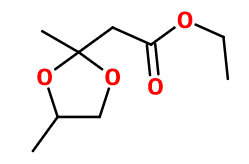
Photo credits: ScenTree SAS
Fraistone®
Fragolane® ; Dimethyl Dioxolan ; Fraisberry® ; Ethyl 2-(2,4-dimethyl-1,3-dioxolan-2-yl) acetate ; 2,4-dimethyl-1,3-dioxolane-2-ethyl acetate ; Dimethyldioxolan ; Ethyl 2-(2,4-dimethyl-1,3-dioxolan-2-yl)acetate ; Ethyl aceto acetate PG acetal ; Ethyl acetoacetate propylene glycol ketal ; Fructone B ; Fruity ketal ; Propyl fruitat ; Strawberry ketal

Photo credits: ScenTree SAS
Do you sell any of the raw materials? Would you like to let our users know?
Send an email to fournisseurs@scentree.coto learn about our advertising opportunities.
Do you sell any of the raw materials? Would you like to let our users know?
Send an email to fournisseurs@scentree.coto learn about our advertising opportunities.
General Presentation
-
CAS N° : 6290-17-1
-
EINECS number : 228-536-2
-
FEMA number : 4294
-
Density : 1,042
-
Optical rotation : Donnée indisponible
-
Allergens : This ingredient does not contain any allergen.
-
Refractive Index @20°C : Donnée indisponible
-
Volatility : Head/Heart
-
Price Range : €€
-
Appearance : Colorless liquid
-
FLAVIS number : 06.087
-
JECFA number : 1715
Information on synthetic ingredients
-
Acid Value : Donnée indisponible
-
Boiling Point : 85°C
-
Detection Threshold : Donnée indisponible.
-
Molecular formula : C9H16O4
-
Log P : 1,5
-
Molecular Weight : 188,22 g/mol
-
Fusion Point : -68°C
-
Flash Point : 91°C
-
Vapor pressure : Donnée indisponible
Uses
Other comments :
Stability :
Stable in perfumes and diverse functional bases
Uses in perfumery :
Fraistone® is used in fruity and floral notes of fruity rose, tuberose, jasmine, orange blossom and syringua.
Year of discovery :
1937
Isomerism :
Fraistone® has two asymmetric carbons. It is however a mixture of isomers that is used in perfumery.
Synthesis precursor :
Fraistone® is not a precursor to the synthesis of another compound of olfactory interest.
Natural availability :
Fraistone® is not available in its natural state.
Synthesis route :
Fraistone® is an acetal of Ethyl Acetoacetate (a synthesis based on formic acid and acetone in its enolic form). It is obtained by reaction between this reagent and propan-1,2-diol.
Regulations & IFRA
This ingredient is not restricted

